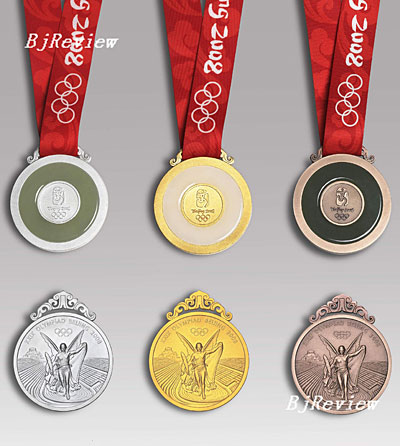|

On March 1, artisans at the Shanghai Mint were about to add the finishing touch to 3,030 jade rings. These jade rings will be mounted on the reverse side of the medals to be presented at the 2008 Beijing Olympics Games. A ring will encircle the Beijing Games emblem engraved on metal in the center of each medal. The designers of the medals were inspired by China's ancient jade piece inscribed with dragon patterns. On the obverse side of the medals is the standard design authorized by the International Olympic Committee.
Why jade?
"After weighing many design ideas carefully, we settled for jade because it is very special," said Hang Hai, associate professor specializing in graphic design in China Central Academy of Fine Arts, who is a key member of the Olympics medal design team of the university. The design of Hang's team was adopted by Beijing Organizing Committee for the Games of the XXIX Olympiad (BOCOG). Hang said that jade was chosen because it has been treasured in China for thousands of years, and it symbolizes the Chinese culture.
The International Olympic Committee has two specific requirements for the design of the medals to be used in the Beijing Games: First, it should be unique; second, it should have Chinese characteristics. The design of Hang's team has certainly met both requirements.
Jade has been used in China since the New Stone Age, about 10,000 years ago. Considered to be sacred and mysterious, jade was often used in religious services and important ceremonies. It has been widely loved in China for its elegant color and beautiful texture, the pleasant sound it sends out when knocked on wood and the refreshing feeling it gives when touched. Moreover, it also stands for virtue and nobility in the Chinese culture. Jiang Xiaoyu, Vice President of BOCOG remarked that jade blended Chinese culture into the Olympic spirit and would make the medals of the Beijing Olympic Games very special. Jiang believed that jade would be the right thing to honor the ethics and achievements of Olympics winners.
BOCOG's global search for the design of the Beijing Olympic medals started on January 11, 2006. In the three months thereafter, it received 265 designs from home and abroad. Then, experts in art design, engraving and minting were invited to conduct several rounds of reviews of 179 short-listed designs. Relevant organizations were also asked to revise the draft designs. The final design was approved by BOCOG on January 11, 2007 and by the IOC on February 8 of the same year.
The design team in China Central Academy of Fine Arts was picked as the winner. The team had 15 members, most of whom were students. In the beginning, they had not thought of using jade as the raw material. They tried to replicate jade sculpture with metals. "No matter how hard we tried, we could not make metals look like jade," Liu Yang, a team member recalled. The right decision came on Liu's graduation day, July 3, 2006, when the team decided to use jade.
In the beginning, the team placed jade at the center of the medals and planned to engrave the Beijing Games emblem on it. Yet, due to the unique color and texture of jade, the emblem looked fuzzy. Then the team became inspired by ancient jade pieces decorated with dragon patterns, and decided to use a jade ring around a metal heart inscribed with the emblem. The design team also picked the shades of the jade carefully so that they would match the colors of the medals, with white jade for the gold, light green for the silver, and dark green for the bronze.
|
